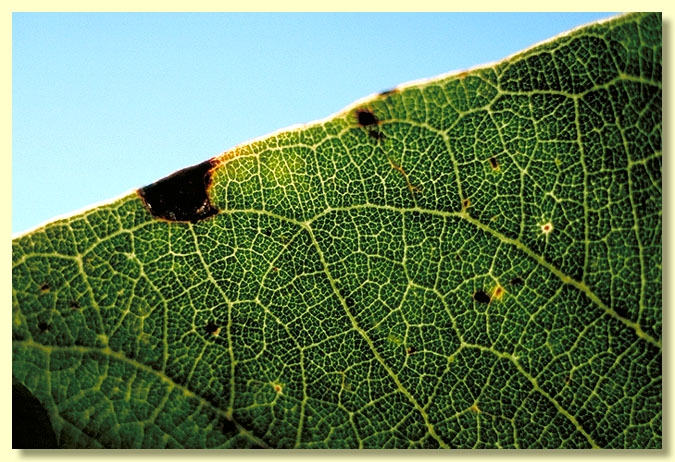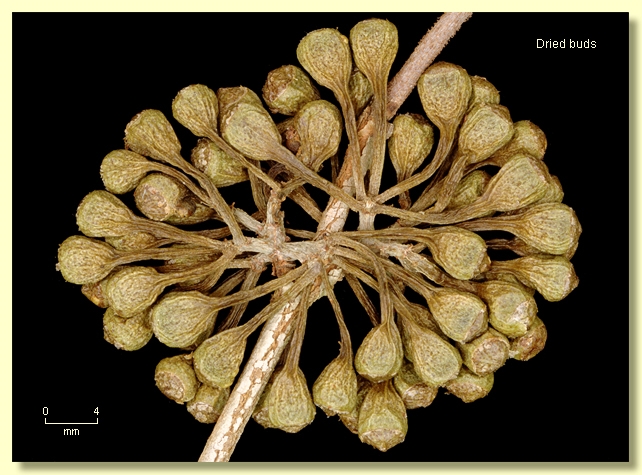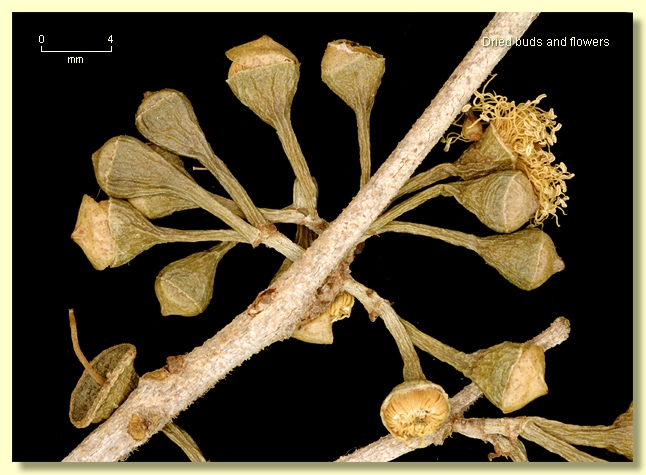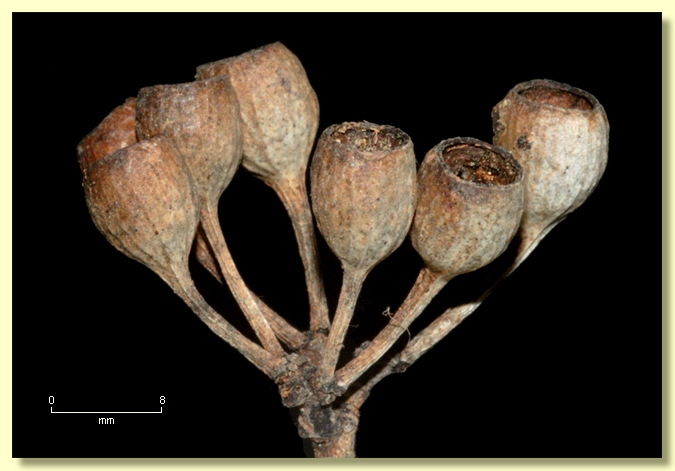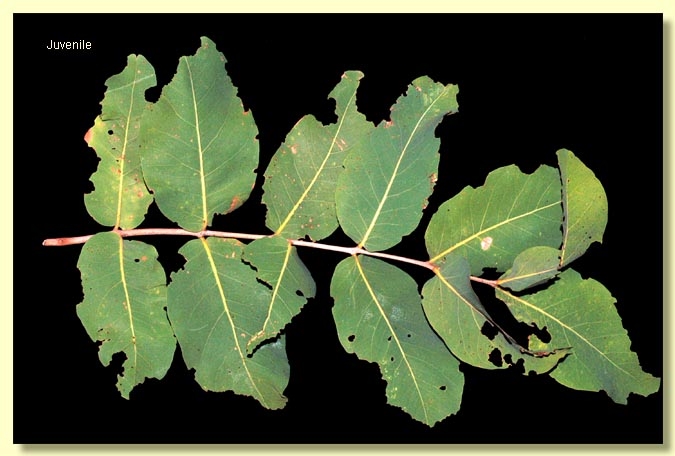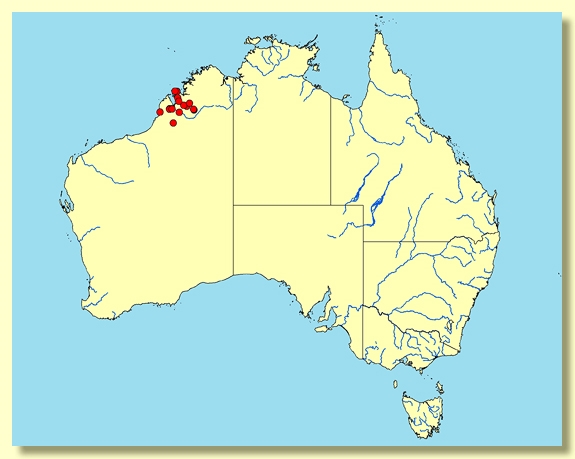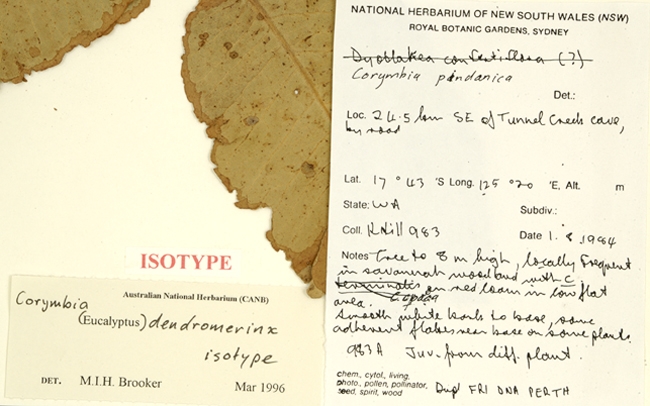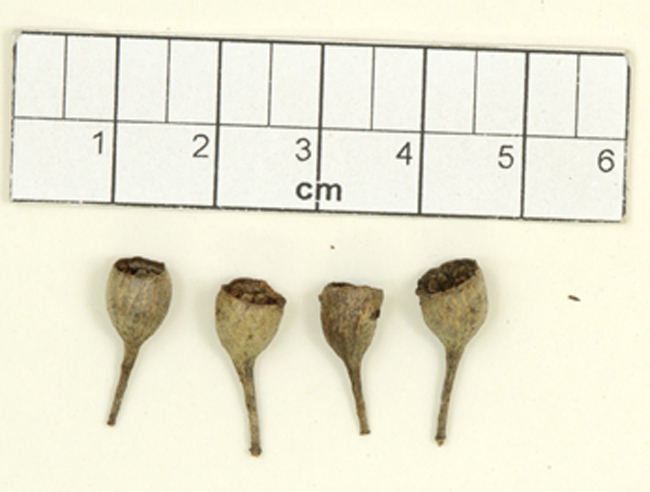Euclid - Online edition
Corymbia dendromerinx
Corymbia | Blakearia
Corymbia dendromerinx K.D.Hill & L.A.S.Johnson Telopea 6: 431 (1995).
Tree 10 m tall, semi-deciduous in the dry season. Forming a lignotuber.
Bark smooth throughout, or with a 0.5 m stocking of thin flaky grey rough to scaly bark on the lower trunk, not clearly tessellated nor with clearly demarcated transition to smooth bark; smooth bark white shedding in thin small sheets to show cream new bark; often powdery.
Branchlets lack discrete oil glands in the pith, however some elongated more duct-like cavities present; younger branchlets scabrid to densely setose. In this species the setae (bristle-glands) bear numerous simple hairs and thus may appear branched.
Juvenile growth (coppice or field seedlings to 50 cm): stems rounded in cross-section, densely setose with setae bearing small simple hairs; leaves opposite, always petiolate with petioles ca 0.2–1 cm long, cordate to ovate, 10–22.5 cm long, 5.5–13 cm wide, base usually lobed, stem-clasping when petioles are short, or sometimes rounded, margin entire, apex rounded, green, discolorous, setose.
Crown of intermediate to adult leaves, opposite or alternate, always petiolate, petioles 0.2–1.2(1.8) cm long; oblong-elliptic to cordate or ovate or tending to lanceolate, 6–15 cm long, 3.6–8.5(10) cm wide, usually undulate, base lobed or rounded, margin entire or distantly indented, apex rounded or pointed, concolorous, dull, green, densely setose with bristle-glands bearing simple hairs and thus appearing branched, side-veins at greater than 45° to midrib, reticulation dense to very dense, intramarginal vein present, oil glands obscure.
Inflorescence borne on leafless branchlets below new season’s leaf growth, axillary compound, the rhachis consisting of a basal internode ca 0.2–0.5 cm long, a second internode absent or to 0.5 cm long, and peduncles of variable length within a single inflorescence, 0.1–1.1 cm long, buds in 7s and ?3s, strongly pedicellate (pedicels 0.6–1.8 cm). Mature buds pyriform to obovoid, 0.5–0.7 cm long, 0.4–0.6 cm wide, smooth, scar present (outer operculum shed early), operculum shallowly rounded to flattened, stamens inflexed, all fertile, anthers oblong, dorsifixed, versatile, dehiscing by longitudinal slits, style long and straight, stigma tapered, locules 3, the ovules not arranged in distinct vertical rows on the placentae. Flowers creamy white.
Fruit pedicellate (pedicels (0.2)0.7–1.7 cm long), barrel-shaped or cylindrical to cupular, 0.7–1.2 cm long, 0.6–0.8 cm wide, thin-walled, disc descending vertically, valves 3, enclosed.
Seeds brown, saucer-shaped, smooth, hilum ventral.
Cultivated seedlings (measured at ca node 10): not grown
Flowering has been recorded in October and November.
A ghost gum tree restricted to the south-western Kimberley region of Western Australia, where it is common, occurring from Leopold Downs and the country south of the King Leopold Range, west to the Grant Range, almost to Derby and north to Oobagooma and the coastal Cockatoo and Koolan Islands, and south west towards Broome. It prefers plains or flat sites with sandy to silty soils but on the islands can be on a variety of substrates from shale to red soil over haematite. Corymbia dendromerinx is a small to moderate-sized tree that is semi-deciduous in the late dry season, with mostly smooth trunk often with a thin scaly rough bark on the butt, a crown of predominantly elliptic-oblong petiolate leaves that are setose to scabrid, inflorescences that are borne on last year's branchlets, with buds that are long pedicellate.
C. dendromerinx is very closely related to three other species—the widespread C. disjuncta and C. confertiflora and the Northern Territory endemic C. pauciseta. These species, together with a fifth taxon described by Hill & Johnson (1995) as Corymbia karelgica but not recognised in EUCLID, form a natural group and, prior to 1995, were all included under the name Eucalyptus confertiflora. The division of E. confertiflora into several species was made in an attempt to resolve the wide variation in petiole length, leaf shape and size, leaf vestiture type and density, and pedicel length seen across its geographic range which covers all of monsoonal northern Australia. Some specimens, especially those variable in leaf shape within the one tree crown, may be impossible to determine satisfactorily to species level without resorting to geography and perhaps not even then.
C. dendromerinx differs from C. disjuncta and C. confertiflora in its smooth to thin scaly rough bark (clearly tessellated and demarcated in C. disjuncta and C. confertiflora), pedicels that are 0.6–1.8 cm long (1.5–3.5 cm long in C. disjuncta and 0.7–3 cm long in C. confertiflora), and predominantly elliptic-oblong crown leaves with petioles 0.2–1.2(1.8) cm long (1–4 cm long in C. disjuncta and 0–0.5 cm long in C. confertiflora ). The setae on branchlets and newly developed leaves of C. dendromerinx bear numerous simple hairs giving each seta a branched appearance, whilst in C. disjuncta and C. confertiflora these simple hairs are few or lacking altogether on the setae. C. karelgica from the central Kimberley region, from Karunjie to south of the Phillips Range, appears to be an intermediate form of ghost gum where the foliage has both a high density of setae and the setae are much adorned with simple hairs, as in C. dendromerinx, but otherwise many trees have broader leaves and longer petioles and thus are more similar to C. disjuncta.
In the Broome area the hybrid ghost gum Corymbia paractia occurs on coastal deep red sands. C.dendromerinx is purported to be one of the parents the other being C. flavescens. C. dendromerinx occurs inland a short way from Broome. C. paractia differs in its tumbledown habit and crown of glabrous adult lanceolate leaves with some setose juvenile/intermediate leaves also present.
The original description of Corymbia dendromerinx seems not to have included the full variation of the material chosen as the type material. In the protologue Hill & Johnson (1995, p.431) state that the mature leaves of C. dendromerinx have petioles 0.2–0.8 cm long, yet the CANB isotype has petioles 0.6–1.7 cm long, atypical of specimens collected throughout the range of of the species.
MORE ABOUT CORYMBIA
MORE ABOUT GHOST GUMS
Corymbia dendromerinx: Greek dendron, tree and merinx, a bristle, referring to the setae (bristle-glands) found on branchlets and leaves. The setae are adorned with simple hairs and are vaguely "tree-like" in appearance when viewed under a microscope.



